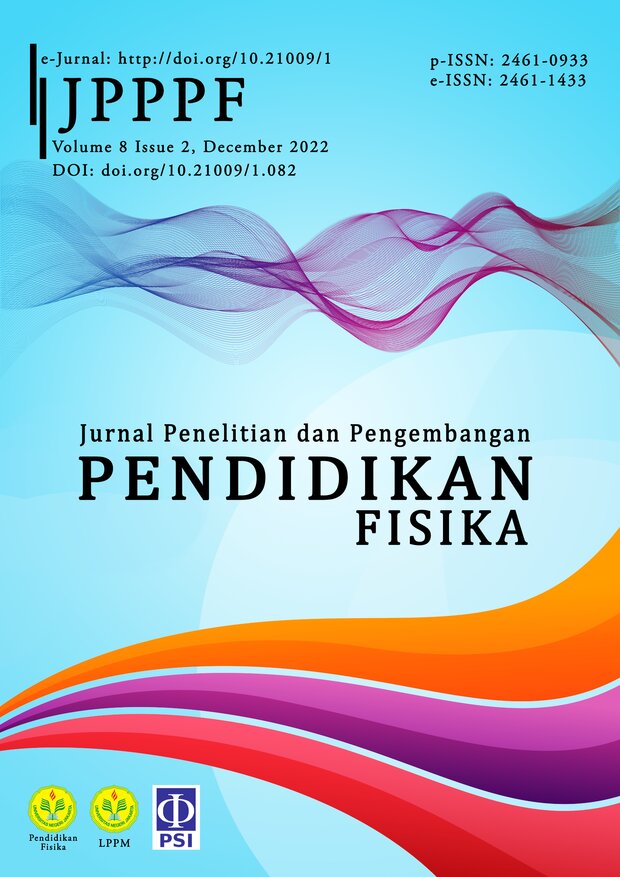Needs Analysis for Developing Project-Based Learning Outcomes Assessment Models in Electricity topic at the Center of Excellence Vocational High School
DOI:
https://doi.org/10.21009/1.08214Keywords:
assessment, outcomes, project-based learning, vocational high schoolAbstract
This study aims to analyze the needs of the project-based learning outcomes assessment model at the Center for Excellence in Vocational High Schools. The first step in the research is the development of Project-Based Learning Assessment Models. Electricity was chosen because it is one of the intersecting materials in the departments at Vocational High Schools. The survey method was chosen to collect information on the needs of the assessment model. The survey data were analyzed using descriptive statistics. The mode of the survey data was used to draw the required model conclusions.The number of respondents who filled out the questionnaire was from 10 SMK-PK in DKI Jakarta, West Java, Banten, and Lampung who applied Project-Based Learning in Practical Teaching. From the respondents' answers, it can be concluded that. Most schools require specific Guidelines for the Assessment of Project-based Learning yet to be made available. Most teachers require industry involvement in the creation of Practice-based Learning assignments. A large number of teachers need an assessment of the quality of assignments. Assessment of the Project-based Learning Process tends to be carried out at the implementation stage, while in the planning and reporting stages, it is carried out by a few teachers. The assessment tends to be carried out against groups with aspects assessed as competence and student performance. The assessment techniques carried out include written tests, observations, and portfolios. Standard sample documents required include Instrument Indicators and Rubrics.
References
Arlan, Zalili Sailan, and A. L. (2019). Code-Switching And Code-Mixing In English Language Teaching And Learning At SMA Negeri 2 Kendari. JLEET Journal of Language Education and Educational Technology, 4(1). http://ojs.uho.ac.id/index.php/JLEET/article/view/6668
Asyifa, U., Emzir, & Nuruddin. (2018). Analisis Linguistik Prinsip Kerjasama Dalam Tuturan Cerita Humor Nawarudir Juha Li Al-Athfal. Journal of Arabic Studies, 3(2), 157–166. https://doi.org/http://dx.doi.org/10.24865/ajas.v3i2.84
Bastiar, I., Marmanto, S., & Sumarlam, S. (2018). Code-Switching in Selling and Buying at Segiri Market Samarinda, East Kalimantan: a Sociolinguistics Study. Lingua Cultura, 12(1), 83. https://doi.org/10.21512/lc.v12i1.4013
Costa, R. F. (2015). Alih Kode dan Campur Kode Pada Gelar Wicara Hitam Putih dan Implikasinya. Jurnal Kata (Bahasa, Sastra, Dan Pembelajarannya), 1–9. http://jurnal.fkip.unila.ac.id/index.php/BINDO1/article/view/11874
De Bruin, A., Samuel, A. G., & Duñabeitia, J. A. (2018). Voluntary language switching: When and why do bilinguals switch between their languages? Journal of Memory and Language, 103(July), 28–43. https://doi.org/10.1016/j.jml.2018.07.005
Fanani, A., & Ma’u, J. A. R. Z. (2018). Code switching and code mixing in English learning process. LingTera, 5(1), 68–77. https://doi.org/10.21831/lt.v5i1.14438
Firima, L. (2018). Code Mixing in Writing Opinion on Media Indonesia Newspaper. BAHTERA : Jurnal Pendidikan Bahasa Dan Sastra, 17(1), 100–110. https://doi.org/10.21009/bahtera.171.8
Herdiana, Y., & Sopian, I. (2019). Alih Kode Dan Campur Kode Pada Naskah Drama Kabayan Mencari Cinta Karya Salsabila Piriyanti. Parole Jurnal Pendidikan Bahasa Dan Sastra Indonesia, 2(2001), 165–170. https://journal.ikipsiliwangi.ac.id/index.php/parole/article/view/1997
Khikmah, E. (2018). Campur Kode dan Alih Kode Pada tuturan Kelompok Masyarakat Multilingual di Kampung Inggris Pare Kediri. Bapala, 5(2), 1–11. https://jurnalmahasiswa.unesa.ac.id/index.php/bapala/article/view/29044
Kurniasih, D., & Zuhriyah, S. A. (2017). Alih Kode Dan Campur Kode Di Pondok Pesantren Mahasiswa Darussalam. Indonesian Language Education and Literature, 3(1), 53. https://doi.org/10.24235/ileal.v3i1.1521
L.R.Gay, Mills, G. E., & Airasian, P. (2012). Educational Research : Competencies for Analysis and Applications (10th Ed.). Pearson Education, Inc.
Mahesa, N. (2017). Alih Kode dan Campur Kode Pemakaian Bahasa Indonesia Dalam Interaksi Pembelajaran di Kelas (Penelitian Etnografi Komunikasi di SD Negeri 14 Gurun Laweh Padang). BAHTERA : Jurnal Pendidikan Bahasa Dan Sastra, 16(1 Januari), 41. https://doi.org/10.21009/bahtera.161.04
Meldani, A. (2018). Alih Kode dan Campur Kode Dalam Novel “The Sweet Sins” Karya rangga Wirianto Putra. Jurnal Sapala, 5(10), 1–11. http://jurnalmahasiswa.unesa.ac.id/index.php/jurnal-sapala/article/view/22521/20638
Murniati. (2015). Alih Kode dan Campur Kode Pada Mahasiswa PBSI dan Implikasinya. Jurnal Kata (Bahasa, Sastra, Dan Pembelajarannya), 3(5), 1–9. http://jurnal.fkip.unila.ac.id/index.php/BINDO1/article/view/9969
Pratiwi, K. S. A. (2015). Code Switching in the Diary Entitled Kambing Jantan By Raditya Dika. Humanis, 10(1), 1–7. http://ojs.unud.ac.id/index.php/sastra/article/viewFile/12154/8421
Puspawati, I. (2018). Teachers’ Use of Code Switching in EFL Classroom and its Functions. Journal of Foreign Languange Teaching and Learning, 3(1), 73–74. https://doi.org/10.18196/ftl.3128
Ramadhan, N. G. (2015). Code Mixing and Code Switching Analysis in Ranah 3 Warna Novel Written by Ahmad Fuadi. LANTERN (Journal on English Language, Culture and Literature), 4(4). https://ejournal3.undip.ac.id/index.php/engliterature/article/view/9541
Rini, M. Natsir, & R. S. (2019). Code Switching in Dior and I Film. Jurnal Ilmu Budaya, 3(1), 52–61. http://e-journals.unmul.ac.id/index.php/JBSSB/article/view/1582
Rohmani, S., Fuady, A., & Anindyarini, A. (2013). Analisis Alih Kode Dan Campur Kode Pada Novel Negeri 5 Menara Karya Ahmad Fuadi. Jurnal Penelitian Bahasa, Sastra Indonesia, Dan Pengajarannya, 1(2), 328–345.
Salzmann, Z., & Auer, P. (2000). Code-Switching in Conversation: Language, Interaction and Identity. In Language. Routledge.
Sehiling, Y., & Setiawan, S. (2014). 10The Students’ Attitudes Toward the Instructor’s Code Switching in EFL Classroom. Language Horizon, 2(1), 1–7. https://jurnalmahasiswa.unesa.ac.id/index.php/language-horizon/article/view/6965
Shay, O. (2015). To Switch or Not to Switch: Code-switching in a Multilingual Country. Procedia - Social and Behavioral Sciences, 209(July), 462–469. https://doi.org/10.1016/j.sbspro.2015.11.253
Spallanzani, Z. T. (2015). Code Mixing and Code Switching in “Cosmopolitan Indonesia” Magazine. LANTERN (Journal on English Language, Culture and Literature), 4(3). https://ejournal3.undip.ac.id/index.php/engliterature/article/view/8980
Susmita, N. (2015). Alih Kode dan Campur Kode dalam Pembelajaran Bahasa Indonesia di Smp Negeri 12 Kerinci. Jurnal Penelitian Jambi Seri Humaniora, 17(2), 89–98.
Wahyudi, R. T., Arifin, M. B., & Setyowati, R. (2018). Code switching in eastern promises film. Jurnal Ilmu Budaya, 2(3), 301–310. http://e-journals.unmul.ac.id/index.php/JBSSB/article/view/1244
Wang, L., & Liu, H. (2016). Syntactic differences of adverbials and attributives in Chinese-English code-switching. Language Sciences, 55(866), 16–35. https://doi.org/10.1016/j.langsci.2016.02.002
Yudita, C. (2019). Code Switching in English Language Learning at Pabelan Islamic Boarding School. RETORIKA: Jurnal Ilmu Bahasa, 5(2), 148–158. http://ejournal.warmadewa.ac.id/index.php/jret/article/view/1204/pdf
Yuliana, N., Luziana, A. R., & Sarwendah, P. (2015). Code-Mixing and Code-Switching of Indonesian Celebrities: A Comparative Study. Lingua Cultura, 9(1), 47. https://doi.org/10.21512/lc.v9i1.761
Yulianti, V., Mayuni, I., & Lustyantie, N. (2019). Developing Sociolinguistic Awareness of Indonesian Learners Through Online Intercultural Exchange in Japanese Language Learning. 178(ICoIE 2018), 420–423. https://doi.org/10.2991/icoie-18.2019.90
Yusuf, Y. Q., Fata, I. A., & Chyntia. (2018). Types of Indonesian-English code-switching employed in a novel. Kasetsart Journal of Social Sciences, 2–7. https://doi.org/10.1016/j.kjss.2018.02.004











